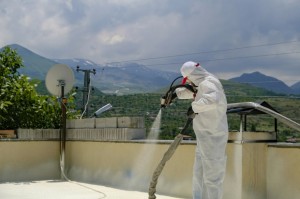Attitudes towards materials can change dramatically over time. Ones that were incredibly popular at one point can soon become blacklisted. It is happening more often today because of the push to be more sustainable. Luckily, developments in recycling techniques can change attitudes yet again. We want to look at this today with polyurethane. Then, if you need help with residential architecture in London, you can talk to us.
Changing fortunes
 The history of polyurethane is really interesting. It was originally developed in the 1930s in Germany. At the time there was a shortage of natural rubber because of a number of factors, including a huge spike in demand, loss of trees in Brazil (the biggest producer in the world at the time), and the start of WWII. With rubber in short supply and prices increasing, finding a cheaper alternative was the order of the day. Polyurethane was one of the biggest developments.
The history of polyurethane is really interesting. It was originally developed in the 1930s in Germany. At the time there was a shortage of natural rubber because of a number of factors, including a huge spike in demand, loss of trees in Brazil (the biggest producer in the world at the time), and the start of WWII. With rubber in short supply and prices increasing, finding a cheaper alternative was the order of the day. Polyurethane was one of the biggest developments.
Users took to polyurethane quickly when they saw it was cheap and versatile. As a foam, it could offer fantastic flexibility. It could easily be sandwiched between other materials to cater for various needs. Ultimately, it became a popular choice for many industries, from construction to automotive and refrigeration. It could serve many needs, including insulating panels and boards.
However, the popularity has been wavering more recently. With more focus on the environment, people are being careful when choosing materials for various projects. We’ve seen this with things like residential architecture in London.
Sadly, polyurethane is a non-biodegradable material. Recycling it is tricky too. As a result, generally waste goes to landfill or incineration. Both have a negative impact on the environment. For example, while incinerating the waste can generate energy, it can also release toxic substances. Waste can sit in landfills for centuries, and even allow substances like flame retardants to leach into the ground.
What next?
Luckily, there have been some interesting developments with polyurethane recycling. A number of methods are available now. For example, chemical recycling can break it down into chemical components. They can then have new uses.
Mechanical recycling is another option for polyurethane waste. This cuts or grinds it up into small particles. It can then be formed into new foam products, including rigid boards. Purman have developed an impressive method that is more energy efficient and cost effective. They use lignin instead of petrochemical binders. As a result, the recycled foams have better mechanical properties, including density and fire resistance.
Ask us about residential architecture in London
The rise, fall, and developments with polyurethane show why it is so important to think carefully about what materials to use. It is especially vital with construction. If people want greener, more sustainable homes and buildings, they need to think far into the future. Look at what will ultimately happen to the resources. Will they go to landfill? Or have you chosen materials that can be recycled and become something new?
If you are planning a project and want an expert to help you examine the pros and cons of different materials, speak to us. We excel at residential architecture in London and much more. So, bring any kind of work to us and we’ll give you the support you need.
